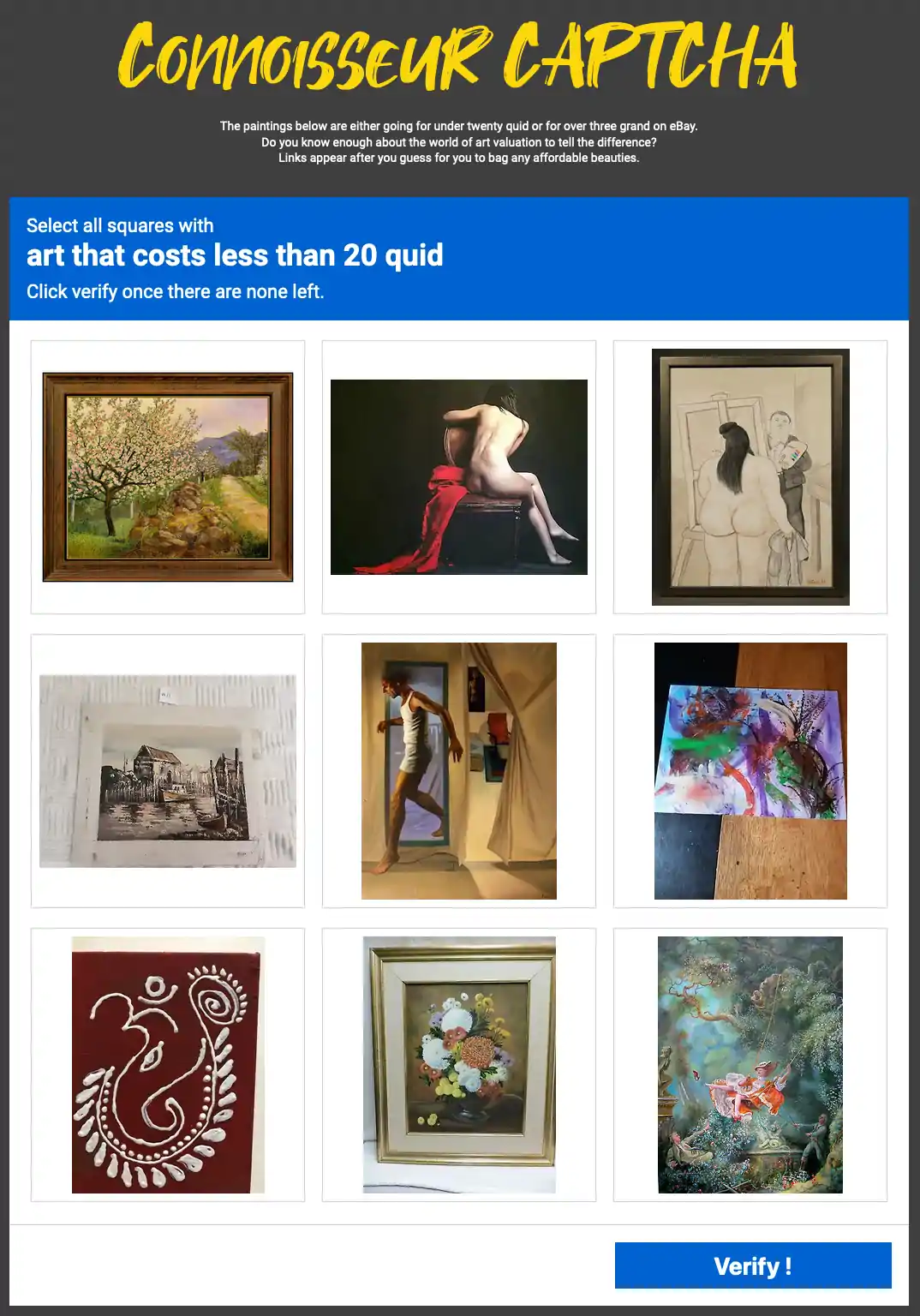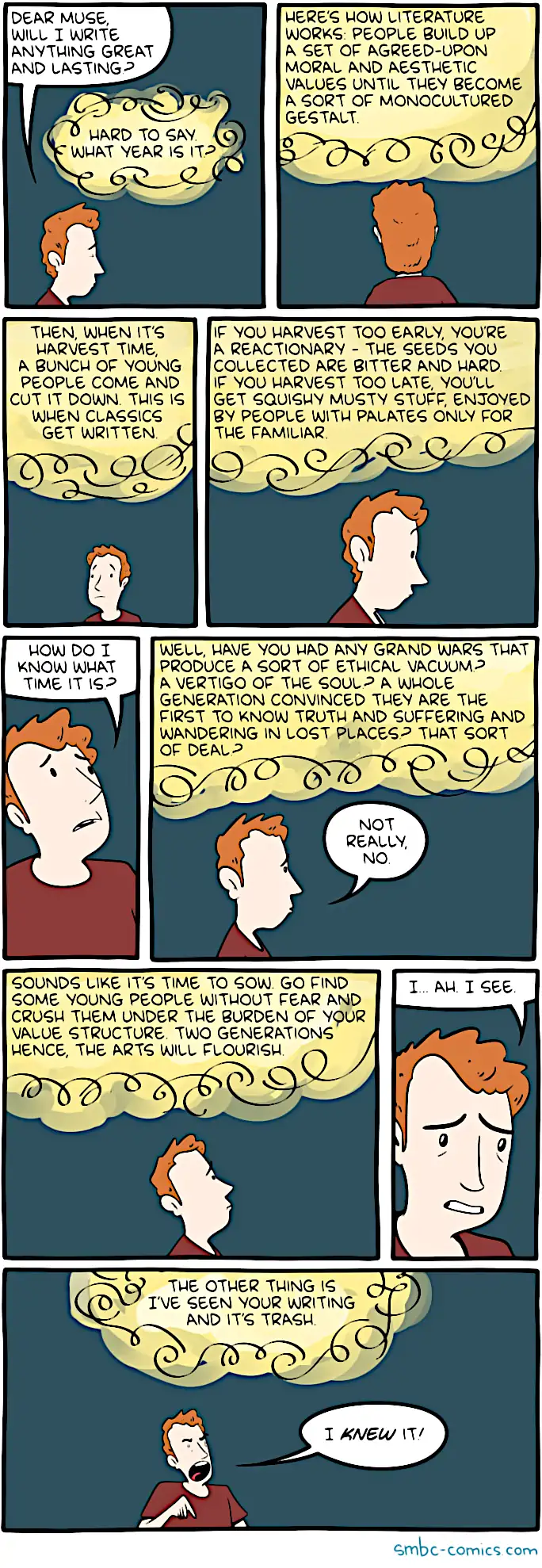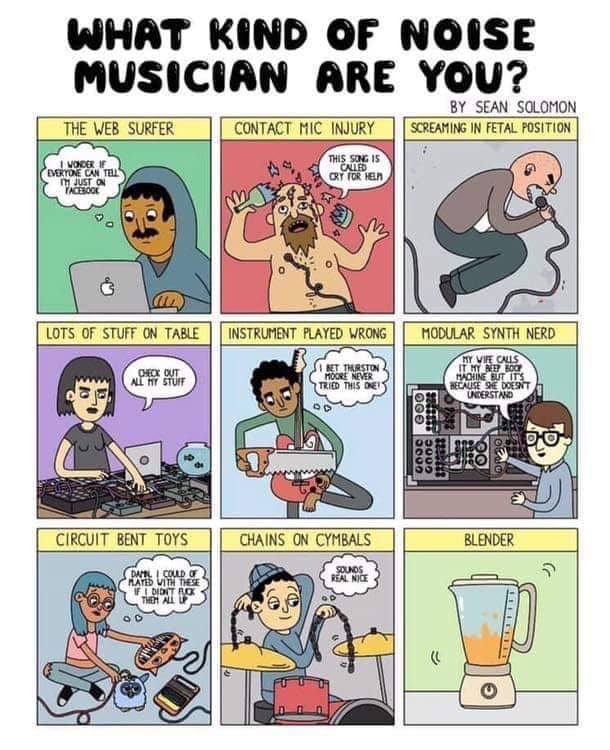Timeless works of art
Aesthetics as a conditional average treatment effect
January 13, 2015 — August 7, 2023
1 Relevance and dialogue
The “suck fairy”. “Too soon”. The artistic experience of red queen signalling and subculture dynamics are both relevant to the current situation. The purity of the ungrammable.
Toby Shorin, Diminishing Marginal Returns of Aesthetic Value:
Between the zone of normalcy and the zone of experimentation, there is a sweet spot. Just outside what is considered normal yet familiar enough to be comprehended, this is where good marketers work. When Weiden Kennedy says they want to capture “lightning in a bottle” this is what they mean: to take something just outside of mainstream culture, aestheticize it, and turn it into marketing for a consumer product. […]
The crowdfunding and tiny brand revolutions indicate that the business entity can be a means of self-expression and an aesthetic medium of its own. Pop-up shops and one-off capsule collections are effective single-shot versions of this medium, but projects with greater ambitions are emerging as well. LOT2046 and Urbit are vehicles for a set of values for with distinct auteurial aesthetic visions.
Gertrude Stein:
What did you think of what you saw, asked Miss Stein. […] that the Picassos were rather awful and the others were not. Sure, she said, as Pablo once remarked, when you make a thing, it is so complicated making it that it is bound to be ugly, but those that do it after you they don’t have to worry about making it and they can make it pretty and so everybody can like it when others make it.
2 Art and subculture
Subculture is the primary way I think about my experience of conceive of art. My stepmother Heidi is a Dressage professional, in fact a competition judge. She can see the art in what those horses do that I cannot.
I, by contrast, am immersed in certain genres of electronic music (left field bass, jungle), occasionally professionally, and can hear things in music that she cannot.
Is one of us delusional in the enjoyment we get from seeing virtuosic performances in our artform? I personally do not think so.
I have a harder time adopting this attitude when someone likes something similar to what I like, but I hate it. (psy-trance, say). Am I a good judge of art in my own area, and correct that psy-trance is terrible? Is nothing terrible?
A lot is written about aesthetics of course, I do not want to come up with a theory of all that stuff right here.
But I do want to think about context of appreciating something pretty for a moment, as that problem that pops up in many fields, to wit
the fixation on finding average effects when the structure of effect differences is what we ought to be interested in.
Is DIY the ultimate microtargetted marketing?
Music styles that, like hip-hop, are connected to some kind of grass roots, are fluid, with constant incremental changes building into epochal ones. When they move from their base audience, it’s often because a particular conjuncture of sounds resonates with a new crowd. But here is where a kind of misrecognition occurs: for the neophytes, the style is this one way, frozen in time. The give and take between music makers and their core followings, the push and pull, ebb and flow that built disco, hip-hop, house, reggaeton, and so on, is interrupted by listeners who in their enthusiasm don’t always understand the history or sociology of their genres. They don’t have to: when music becomes a commodity, it can travel worldwide, as all commodities do, severed from any knowledge of the conditions of its production. Genres cease to be grassroots social worlds, and instead become something more like brands: mere sonic surfaces rather than deep historical processes.
Maximillian Schich for complex network theory with an art history twist.
Mark Bernstein’s Neovictorian Computing series takes the tension between univerality and specificity to the odd world of software:
by “NeoVictorian” I mean systems that are:
- Built for people
- Built by people
- Crafted in workshops
- Irregular
- Inspired
David Marx, 21st Century Culture: Boring or Static? (Or both?)
status value was always key to the appeal of avant-garde and indie culture, and (2) the internet conspires against providing such content with status value. In the ensuing vacuum, the mass media and elite consumers spend their energy engaging with mass culture, which is more likely than niche content to be conventional. And mass culture, by definition, lacks cachet. The most savvy consumers will always desire pop culture that both breaks conventions and offers a sense of cool, and today’s mass hits rarely do either.
He namechecks some other interesting pundits:
Ryan Broderick’s Garbage Day: Our Frustrating Fandom Future
In a world where you can read, watch, or listen to anything, the act of consumption isn’t impressive. So now we reward each other for consuming the meta-text — the memes, the hashtags, the community drama, and the conspiracy theories. Not only does this help small communities canonize their own monocultures, but it also has led to larger mainstream institutions fracturing themselves into small subcultures to more effectively target community members.
Bob Lefsetz, What’s Cool
Used to be there were insiders and outsiders. Hipsters and the hoi polloi. The hipsters were there first, oftentimes what they were into broke through to the mainstream, sometimes it did not. But one thing was for sure, the hipsters lorded their dedication and knowledge over you. You weren’t aware of this? You’re listening to that crap? There were all kinds of bleeding edge phenomena that broke, and almost never instantly. The hipsters had to adopt it and it took years for the rest to catch on.
3 Hyperselection
As someone who makes music the tension between innovation and execution is always in the front of my mind. There is always a scope for things that are imperfectly executed because they are new and edgy, and for things that are polished to perfection.
Recently I have been wondering if the balance has shifted towards polish. It feels like pressure for producing hyper-stylized cookie-cutter EDM sounds as become high. In particular, the need for immaculate studio production has driven out the scope for live, rough, improvised stuff.
To make this precise I would need to check some things; is the appetite for DIY stuff truly shrinking? Or shrinking as proportion of an overall growing market, maybe even actually growing overall?
Discussion point: Youtube thumbnails.
Joe Veix, Your Pretty Face is Going to Sell
Everywhere you look, there’s YouTube Face.
The Face is hard to miss once you first spot it: an exaggerated expression, an overreaction to a given video’s subject, typically conveying heightened states like disgust, anger, or ecstasy. The assault of a bad smell; a bite of something intensely sour; a faked orgasm; an elbow to the guts.
YouTube Face is most prominent in the preview images for videos. It surrounds whatever video you’re watching in a big grid of emotion.
C&C Whither Tartaria?.
5 Incoming
- Taste games - DYNOMIGHT INTERNET NEWSLETTER
- You Need To Be Cringemaxxing - by Mary Harrington
- The Total Value of Art Stays Constant Over Time
- Gavin Leech, Taylor Swift as blurry jpeg
So why does Taylor Swift (your reception of Taylor Swift) make me feel like I have ants beneath my skin?
I think it’s because I am seeing a machine (a series of large corporations and 40+ writers and designers
) represent itself as a singular human being I am to empathise with. Then a large part of society greets this machine as a capital-A artist.
The interesting part is that Swift the human built the machine and controls it in some detail. A self-manufactured pop star: she is deeply invested in making the machine seem like her and in feeding it people (fans, co-writers, boyfriends, enemies, bloggers). The project is reflexive: it makes songs about its own controversies, songs which lead to even more fame, fame which automatically produces more controversies. Call the machine TS.
TS performs characters (Cinderella, say) and at the same time pretends to deeply express Swift the woman. She performed innocence (and a twang) for Nashville and now performs demisexuality (and FKA-sighing) for the glossies, BPD (and drawling) for the extremely online, and a persecution complex (and diphthongs) for everyone.
That’s half of it; the other half is the mediocrity of the output and your incredible overestimation of it. (Bowie pulled off a cheaper version of the TS trick 50 years ago and I love him for it because his songs are, at the very least, interesting and aimed at more than pleasing me.) TS songs are moderately catchy, recently moderately perverse, and expertly ape The Current Thing (Faith Hill / Kelly Clarkson / Jenny Lewis / Lady Gaga / Kesha / Lana del Rey / Lorde / FKA Twigs / whoever it is now). But TS is noticeably flatter than any of these.
Why does the music’s reception matter if the music doesn’t matter? Well, I dislike things that pretend to be deep when they’re not. Things which pretend to be personal are on tricky aesthetic ground. It is not fine for entertainment to stand in place of art. We used to be iffy about parasocial relationships, corporate machines, being played.
- Dean Kissick, Senseless Babble
In the early 2010s, there were movements on both 4chan (anonymous, nihilist trolls) and Tumblr (radicals deconstructing identity) that fulfilled the criteria of being avant-garde: they were coming up with new ways of speaking, new forms of communication and expression, and new ways of being. They offered formal innovations, critiques of modern society, and visions of a different future, all of which were very hard to find elsewhere.
4chan posters adopted some strategies of the historical avant-garde, like transgressive humor, nonsensical absurdity, and culture-jamming, and on their fast-flowing message boards you could watch language and visual culture being collectively remade in real time. Tumblr was more avant-garde still: gender, sexuality, and identity were being pulled apart and reconstructed by young people on it every day, new iteration after new iteration. These users were accelerating toward a new type of human (and beyond it). Both groups produced a kind of communal folk art but were nevertheless avant-garde in their approaches — even if, or more likely because, what they made did not conform to what is traditionally understood as art or culture …
Today’s online culture is far more inventive and daring than the arts, both formally and in terms of the ideas it presents. Ordinary people, it turns out, are far weirder than artists and writers, and more imaginative too.
A side effect of the generative algo-art wave that’s gone at least underappreciated is the total dissolution of the notion that artistic intent exists and is anything worth investigating. Detail and context are no longer avenues of a creator’s comment or venues of study; there’s no point in engaging critically with anything that Midjourney has barfed out, because there’s nothing you could even vaguely call “intent” behind it. The fine details are reduced to the sterility of the forensic.




